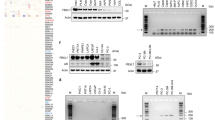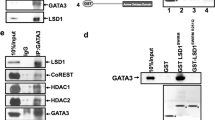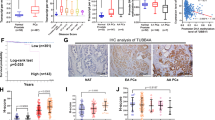Abstract
The epithelial-to-mesenchymal transition (EMT) is a crucial program for the invasion and metastasis of epithelial tumors that involves loss of cell–cell adhesion and increased cell mobility; however, mechanisms underlying this transition are not fully elucidated. Here, we propose a novel mechanism through which the nicotinamide adenine dinucleotide-dependent histone deacetylase SIRT1 regulates EMT in prostate cancer cells through cooperation with the EMT inducing transcription factor ZEB1. We found that forced expression of SIRT1 in non-transformed PZ-HPV-7 prostate epithelial cells disrupts the epithelial morphology concomitant with decreased expression of the epithelial marker, E-cadherin, and increased expression of mesenchymal markers. In contrast, silencing SIRT1 in metastatic prostate tumor cells restores cell–cell adhesion and induces a shift toward an epithelial morphology concomitant with increased expression of E-cadherin and decreased expression of mesenchymal markers. We also found that SIRT1 has a physiologically relevant role in endogenous EMT induced by EGF signaling in prostate cancer cells. We propose that the regulation of EMT by SIRT1 involves modulation of, and cooperation with, the EMT inducing transcription factor ZEB1. Specifically, we show that SIRT1 silencing reduces expression of ZEB1 and that SIRT1 is recruited to the E-cadherin proximal promoter by ZEB1 to deacetylate histone H3 and to reduce binding of RNA polymerase II, ultimately suppressing E-cadherin transcription. We thus identify a necessary role for ZEB1 in SIRT1-mediated EMT. Finally, we show that reduction of SIRT1 decreases prostate cancer cell migration in vitro and metastasis in vivo in immunodeficient mice, which is largely independent of any general effects of SIRT1 on prostate cancer growth and survival. We therefore identify SIRT1 as a positive regulator of EMT and metastatic growth of prostate cancer cells and our findings implicate overexpressed SIRT1 as a potential therapeutic target to reverse EMT and to prevent prostate cancer progression.
This is a preview of subscription content, access via your institution
Access options
Subscribe to this journal
Receive 50 print issues and online access
$259.00 per year
only $5.18 per issue
Buy this article
- Purchase on Springer Link
- Instant access to full article PDF
Prices may be subject to local taxes which are calculated during checkout








Similar content being viewed by others
References
Mimeault M, Batra SK . Recent advances on multiple tumorigenic cascades involved in prostatic cancer progression and targeting therapies. Carcinogenesis 2006; 27: 1–22.
Thiery JP . Epithelial-mesenchymal transitions in development and pathologies. Curr Opin Cell Biol 2003; 15: 740–746.
Thiery JP, Sleeman JP . Complex networks orchestrate epithelial-mesenchymal transitions. Nat Rev Mol Cell Biol 2006; 7: 131–142.
Savagner P . Leaving the neighborhood: molecular mechanisms involved during epithelial-mesenchymal transition. Bioessays 2001; 23: 912–923.
Voulgari A, Pintzas A . Epithelial-mesenchymal transition in cancer metastasis: mechanisms, markers and strategies to overcome drug resistance in the clinic. Biochim Biophys Acta 2009; 1796: 75–90.
Ross JS, Figge HL, Bui HX, del Rosario AD, Fisher HA, Nazeer T et al. E-cadherin expression in prostatic carcinoma biopsies: correlation with tumor grade, DNA content, pathologic stage, and clinical outcome. Mod Pathol 1994; 7: 835–841.
Richmond PJ, Karayiannakis AJ, Nagafuchi A, Kaisary AV, Pignatelli M . Aberrant E-cadherin and alpha-catenin expression in prostate cancer: correlation with patient survival. Cancer Res 1997; 57: 3189–3193.
Peinado H, Portillo F, Cano A . Transcriptional regulation of cadherins during development and carcinogenesis. Int J Dev Biol 2004; 48: 365–375.
Wallerand H, Robert G, Pasticier G, Ravaud A, Ballanger P, Reiter RE et al. The epithelial-mesenchymal transition-inducing factor TWIST is an attractive target in advanced and/or metastatic bladder and prostate cancers(). Urol Oncol 2010; 28: 473–479.
Vandewalle C, Van Roy F, Berx G . The role of the ZEB family of transcription factors in development and disease. Cell Mol Life Sci 2009; 66: 773–787.
Sanchez-Tillo E, Lazaro A, Torrent R, M, Vaquero EC, Castells A et al. ZEB1 represses E-cadherin and induces an EMT by recruiting the SWI/SNF chromatin-remodeling protein BRG1. Oncogene 2010; 29: 3490–3500.
Graham TR, Zhau HE, Odero-Marah VA, Osunkoya AO, Kimbro KS, Tighiouart M et al. Insulin-like growth factor-I-dependent up-regulation of ZEB1 drives epithelial-to-mesenchymal transition in human prostate cancer cells. Cancer Res 2008; 68: 2479–2488.
Smith J . Human Sir2 and the ‘silencing’ of p53 activity. Trends Cell Biol 2002; 12: 404–406.
Bordone L, Guarente L . Calorie restriction, SIRT1 and metabolism: understanding longevity. Nat Rev Mol Cell Biol 2005; 6: 298–305.
Giannakou ME, Partridge L . The interaction between FOXO and SIRT1: tipping the balance towards survival. Trends Cell Biol 2004; 14: 408–412.
Guarente L . Sirtuins in aging and disease. Cold Spring Harb Symp Quant Biol 2007; 72: 483–488.
Guarente L, Picard F . Calorie restriction--the SIR2 connection. Cell 2005; 120: 473–482.
Liu T, Liu PY, Marshall GM . The critical role of the class III histone deacetylase SIRT1 in cancer. Cancer Res 2009; 69: 1702–1705.
Saunders LR, Verdin E . Sirtuins: critical regulators at the crossroads between cancer and aging. Oncogene 2007; 26: 5489–5504.
Yamamoto H, Schoonjans K, Auwerx J . Sirtuin functions in health and disease. Mol Endocrinol 2007; 21: 1745–1755.
Dai Y, Faller DV . Transcription Regulation by Class III Histone Deacetylases (HDACs)—Sirtuins. Transl Oncogenomics 2008; 3: 137–149.
Larue L, Bellacosa A . Epithelial-mesenchymal transition in development and cancer: role of phosphatidylinositol 3′ kinase/AKT pathways. Oncogene 2005; 24: 7443–7454.
Peinado H, Olmeda D, Cano A . Snail, Zeb and bHLH factors in tumour progression: an alliance against the epithelial phenotype? Nat Rev Cancer 2007; 7: 415–428.
Moreno-Bueno G, Portillo F, Cano A . Transcriptional regulation of cell polarity in EMT and cancer. Oncogene 2008; 27: 6958–6969.
Hajra KM, Ji X, Fearon ER . Extinction of E-cadherin expression in breast cancer via a dominant repression pathway acting on proximal promoter elements. Oncogene 1999; 18: 7274–7279.
Hajra KM, Chen DY, Fearon ER . The SLUG zinc-finger protein represses E-cadherin in breast cancer. Cancer Res 2002; 62: 1613–1618.
Eger A, Aigner K, Sonderegger S, Dampier B, Oehler S, Schreiber M et al. DeltaEF1 is a transcriptional repressor of E-cadherin and regulates epithelial plasticity in breast cancer cells. Oncogene 2005; 24: 2375–2385.
Michael E, Israel V . Tail vein assay of cancer metastasis. Curr Protoc Cell Biol 2001: 19.2.1–19.2.7.
Kim EJ, Um SJ . SIRT1: roles in aging and cancer. BMB Rep 2008; 41: 751–756.
Baum B, Settleman J, Quinlan MP . Transitions between epithelial and mesenchymal states in development and disease. Semin Cell Dev Biol 2008; 19: 294–308.
Umbas R, Schalken JA, Aalders TW, Carter BS, Karthaus HFM, Schaafsma HE et al. Expression of the cellular adhesion molecule E-cadherin is reduced or absent in high-grade prostate cancer. Cancer Res 1992; 52: 5104–5109.
Potente M, Ghaeni L, Baldessari D, Mostoslavsky R, Rossig L, Dequiedt F et al. SIRT1 controls endothelial angiogenic functions during vascular growth. Genes Dev 2007; 21: 2644–2658.
Zhang Y, Zhang M, Dong H, Yong S, Li X, Olashaw N et al. Deacetylation of cortactin by SIRT1 promotes cell migration. Oncogene 2009; 28: 445–460.
Eades G, Yao Y, Yang M, Zhang Y, Chumsri S, Zhou Q . MiR-200a regulates SIRT1 and EMT-like transformation in mammary epithelial cells. J Biol Chem 2011; 286: 25992–26002.
Tryndyak VP, Beland FA, Pogribny IP . E-cadherin transcriptional down-regulation by epigenetic and microRNA-200 family alterations is related to mesenchymal and drug-resistant phenotypes in human breast cancer cells. Int J Cancer 2010; 126: 2575–2583.
Huffman DM, Grizzle WE, Bamman MM, Kim JS, Eltoum IA, Elgavish A et al. SIRT1 is significantly elevated in mouse and human prostate cancer. Cancer Res 2007; 67: 6612–6618.
Kwon HS, Ott M . The ups and downs of SIRT1. Trends Biochem Sci 2008; 33: 517–525.
Cha EJ, Noh SJ, Kwon KS, Kim CY, Park BH, Park HS et al. Expression of DBC1 and SIRT1 is associated with poor prognosis of gastric carcinoma. Clin Cancer Res 2009; 15: 4453–4459.
Jang KY, Hwang SH, Kwon KS, Kim KR, Choi HN, Lee NR et al. SIRT1 expression is associated with poor prognosis of diffuse large B-cell lymphoma. Am J Surg Pathol 2008; 32: 1523–1531.
Lee H, Kim KR, Noh SJ, Park HS, Kwon KS, Park BH et al. Expression of DBC1 and SIRT1 is associated with poor prognosis for breast carcinoma. Hum Pathol 2011; 42: 204–213.
Tseng RC, Lee CC, Hsu HS, Tzao C, Wang YC . Distinct HIC1-SIRT1-p53 loop deregulation in lung squamous carcinoma and adenocarcinoma patients. Neoplasia 2009; 11: 763–770.
Ellis AL, Wang Z, Yu X, Mertz JE . Either ZEB1 or ZEB2/SIP1 can play a central role in regulating the Epstein-Barr virus latent-lytic switch in a cell-type-specific manner. J Virol 84: 6139–6152.
Dai Y, Ngo D, Forman LW, Qin DC, Jacob J, Faller DV . Sirtuin 1 is required for antagonist-induced transcriptional repression of androgen-responsive genes by the androgen receptor. Mol Endocrinol 2007; 21: 1807–1821.
Lacher MD, Shiina M, Chang P, Keller D, Tiirikainen MI, Korn WM . ZEB1 limits adenoviral infectability by transcriptionally repressing the Coxsackie virus and Adenovirus Receptor. Mol Cancer 2011; 10: 91.
Dai Y, Ngo D, Jacob J, Forman LW, Faller DV . Prohibitin and the SWI/SNF ATPase subunit BRG1 are required for effective androgen antagonist-mediated transcriptional repression of androgen receptor-regulated genes. Carcinogenesis 2008; 29: 1725–1733.
Shtutman M, Levina E, Ohouo P, Baig M, Roninson IB . Cell adhesion molecule L1 disrupts E-cadherin-containing adherens junctions and increases scattering and motility of MCF7 breast carcinoma cells. Cancer Res 2006; 66: 11370–11380.
Vandewalle C, Comijn J, De Craene B, Vermassen P, Bruyneel E, Andersen H et al. SIP1/ZEB2 induces EMT by repressing genes of different epithelial cell-cell junctions. Nucleic Acids Res 2005; 33: 6566–6578.
Acknowledgements
We thank Dr F Picard (Laval University, Canada), Dr Michael Korn (USCF, CA), Dr M Ott (UCSF, CA) for providing plasmid constructs. We greatly thank the technical support in tumor cell s.c. injection from Dr Zhijun Luo (Boston University School of Medicine). We thank Lora Forman for the technical assistant (Boston University) and Christine Chiao (Boston University) for the proofreading of this manuscript. This work was supported by grants from the National Cancer Institute (1R21CA141036) (YD), the Clinical and Translational Science Institute award of NIH (UL1RR025771) (YD), the National Cancer Institute (CA101992) (DVF), the Karin Grunebaum Cancer Research Foundation (YD and DVF), the American Cancer Society (IRG-72-001-27-IRG) (YD), and the Department of Medicine Pilot Project Grant Award (YD).
Author information
Authors and Affiliations
Corresponding author
Ethics declarations
Competing interests
The authors declare no conflict of interest.
Rights and permissions
About this article
Cite this article
Byles, V., Zhu, L., Lovaas, J. et al. SIRT1 induces EMT by cooperating with EMT transcription factors and enhances prostate cancer cell migration and metastasis. Oncogene 31, 4619–4629 (2012). https://doi.org/10.1038/onc.2011.612
Received:
Revised:
Accepted:
Published:
Issue Date:
DOI: https://doi.org/10.1038/onc.2011.612
Keywords
This article is cited by
-
SIRT1 mediates breast cancer development and tumorigenesis controlled by estrogen-related receptor β
Breast Cancer (2024)
-
NAD+ supplementation limits triple-negative breast cancer metastasis via SIRT1-P66Shc signaling
Oncogene (2023)
-
Epigenetic regulation of hybrid epithelial-mesenchymal cell states in cancer
Oncogene (2023)
-
Protein post-translational modifications in the regulation of cancer hallmarks
Cancer Gene Therapy (2023)
-
Long non-coding RNAs as the critical regulators of epithelial mesenchymal transition in colorectal tumor cells: an overview
Cancer Cell International (2022)



